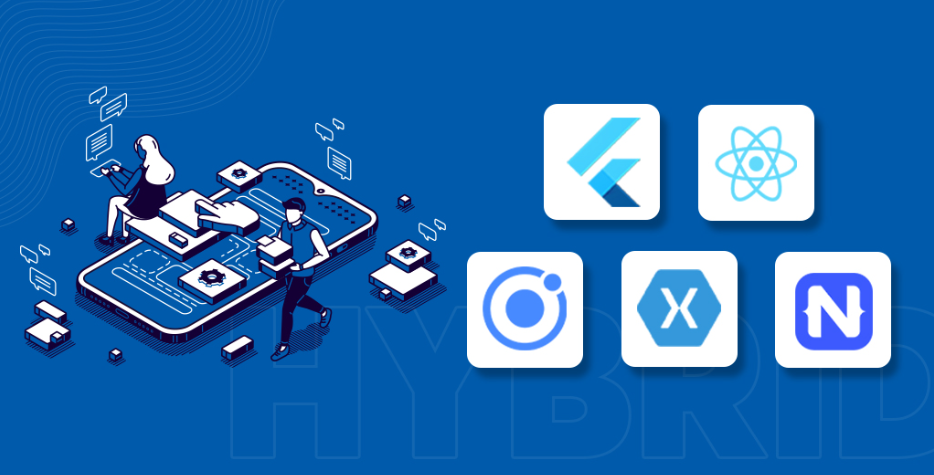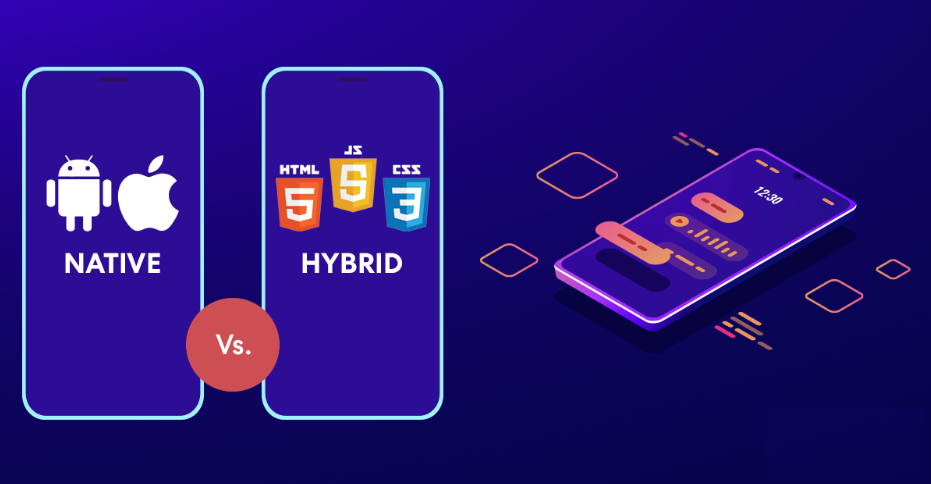Introduction
Mobile applications have indeed become the epitome of innovation, changing the social interaction, commerce, and even entertainment functionalities of our society in today’s digital world. The process of developing a mobile application is a complex journey with a number steps and stages including planning, coding, design, testing, and deployment. The success of a FAAS project plan ultimately depends on the proper selection of native and hybrid strategies, which are analyzed herein below. This guide is designed to offer detailed explanation and models around native and hybrid mobile application development so as to help you make right decisions regarding the apps of your project.
1. Defining Native Mobile Application Development
A. Definition and Characteristics of Native Apps
Native mobile apps are developed for a particular operating system solely and can be iOS, or Android or any other operating system. They are typically written using programming languages and tools that are inherent to the platform to allow better performance in addition to better affiliation with the features of the devices.
B. Advantages of Native Apps
- Performance and Speed: Native apps are considered to be performing better than the web apps as well as they are faster in executing the programs that have direct access to the device hard-ware and are coded specifically for the operating system being used.
- Access to Device Features: They make full use of device functions such as camera, location services, push notification, and movements, to provide a full value proposition to user experience.
- User Experience and Interface: Native apps offer more resemblances with device interfaces and adheres strictly to the design principles of the operating systems hence ensuring consumers more satisfaction and retention.
C. Challenges of Native Apps
- Development Time and Cost: Some of the drawbacks of going with the platform approach include the fact that it leads to the development of different apps, thus consuming a lot of time and money than when using a hybrid approach.
- Platform-Specific Development: It deems maintenance and updates as platform-specific, thus posing an extra challenge through constant supportContinuous updates and maintenance calls for platform-specific efforts, which form an additional layer of challenge when it comes to support.
D. Native Mobile App Development Company
A leading Native Mobile App development company offers app development solutions that are customized to meet every platform’s demand. They are experts in native app development, which makes them keen on providing the best performing and sounding applications.
When looking for a native development company, one needs to consider their checklist, which may include their portfolio, and their clients’ feedback, as well their proficiency in creating applications for the given platforms among others. Search for the companies that have developed the desired high-quality native apps with efficient features that meet the needs of the project.For expert native app development, visit our web application development services page.
2. Hybrid mobile application development and its features

A. Definition and Features of Hybrid Apps
Hybrid applications can be defined as the third type of mobile applications, standing between purely native and web applications. Essentially they are constructed out of web frameworks using HTML, CSS and JavaScript and are packaged in native interfaces for distribution on various operating systems.
B. Advantages of Hybrid Apps
- Cross-Platform Compatibility: It can be deployed to multiple platforms and is compatible with multiple platforms which in turn saves time and resources.
- Faster Development Time: Solutions that use a single codebase for all platforms are beneficial in cases when companies need to shorten the development cycles and/or the time to market.
Cost-Effectiveness: As a consequence of its advantages, consistent development of one codebase saves the cost of developing native applications.
C. Limitations of Hybrid Apps
Performance Issues: These comprise of limitations in terms of performance; in cases where hybrid apps are applied in functional graphics and complicated operations.
Dependency on Third-Party Tools/Frameworks: They use frameworks such as PhoneGap, Ionic or React Native which could restrict them from utilizing some of the native capabilities or even when they do, they need to conduct plugin connections.
D. Hybrid Mobile App Development Company
Leading hybrid mobile application development service providers are expert in offering hybrid mobile application development solutions using best hybrid frameworks that tend to brave the performance issues while creating cross platform applications.
When hiring a hybrid app development firm, you should take an interest in their skills in specific hybrid frameworks, past undertakings, and how much integration and customization they could provide you. Thus, the notion of the strong app development partner should aim at meeting the criteria in performance boost, as well as the compatibility with the cross-platform features.
To explore our hybrid development services, check out our mobile application development page.
3. Consideration of Native and Hybrid Instructions
A. Performance and User Experience
The benchmarking studies tend to indicate how native and hybrid apps work as regards efficiency by displaying that native apps are faster and more responsive. The comparison made by its users has always shown that native apps are in a better position regarding the overall experience.
Nevertheless, more developments have been made to hybrid application frameworks to close this performance gap and it is now providing improved native-like feel. Some of the features that influence results include the number of user actions, the number of transactions per second, and the speed enhancing strategies applied.
B. Development Time and Cost
For hybrid apps there are listed such advantages as faster development cycles and cost savings during the initial stage of the project; however for native apps there are not as many advantages as it can be identified that the performance is better than the hybrid applications and the maintenance issues are also less complicated.
This is where one needs to consider the initial cost of implementing an application that is developed on the hybrid system and some drawbacks that may come with it such as the scalability factor, the optimization that may be required on the platform and the costs of maintaining the application system. Yet, for projects that need to be completed rapidly, and the client’s budget is limited, the hybrid development model is feasible, if the desired performance level is attained.
C. Maintenance and Updates
When an application is developed for the native client then it needs to be updated as a separate entity for the so called platforms and this requires lots more effort and resources. Hybrid apps can be easily maintained but do not always have a problem of compatibility with operating system updates or new gadgets.
The differences of native and hybrid apps thus are that while both require strategic planning and a clear maintenance and update roadmap, the latter requires a middle man formerly named web view. We know how to update it then to prevent making a mistake and using version control alongside agile development or testing, which can save much time and provide a stable cross-platform experience for users.
4. Case Studies and Examples
A. Hybrid App Success Stories
- Airbnb: Airbnb undertook the practice of developing a hybrid mobile application that provides similar experience and feels across the platforms but the developments of such apps are much easier and convenient with the help of React Native.
- Basecamp: The tested Basecamp hybrid app proves the relevance of minimizing the need for different platform-specific builds while achieving excellent usability and performance.
B. Lessons Learned from Real-World Projects
Reviewing case studies introduces important information about native and hybrid approaches, strengths, and weaknesses that can help to shape further app development strategies.
Not only the mentioned above, to understand the result of native and hybrid approaches used in particular situations we can search through some industry-level examples. Professions like healthcare, finance, online business, or gambling may have addressed specifications that drive the paradigm selection process for development.
5. Factors Influencing the Choice
A. Project Requirements and Goals
The context of the application, its capabilities as well its audience defines the direction for selecting the development model. For instance, apps that demand to have high-quality graphics, real-time activities or offline applications may prefer native.
To begin with, apps that need to have highly graphical perception to them, citizens involvement in real-time or need to operate offline may opt for native.
B. Target Audience and User Expectations
Into account, staying informed about the user preferences and the way they engage with the device and with the application also the user expectations toward the app will assure more adequacy to the market trends. Finally, it is wise to use user surveys and questionnaires, examine the results of usability testing, and analyze the standings of your competitors.
C. Budget and Resources
This paper also examines complete native or hybrid development prospects by considering factors such as, budget constraints, required development period, and resources available at the time of project initiation. Before adopting any framework, potential implementers have to decide the following questions: how complex is development, whether it has to scale, and what’s the cost of maintenance in the long run?
D. Long-Term Scalability and Maintenance
Maintenance, updates, the always evolving ability to expand the app’s functions and readiness for future updates all have a profound influence on the choice between native and hybrid frameworks. In the context of scalability planning the designers should consider the possibility of increase in users, improvements of the features provided by the app, and in the technologies used to power it so that the app would be able to stay on the market and relevant.
6. Best Practices and Recommendations
A. Choosing the Right Development Approach
Analyze your projects in terms of their needs and expected parameters or define long-term goals in order to decide whether you need a purely native or more flexible and integrated native/hybrid approach. Consider factors such as:
– Complexity of Features: First, analyze the amount and detail of the features to be developed in the application, as well as the level of functionality that the users should be able to expect. However, native development may be more appropriate for applications that interface heavily with the device’s hardware or feature intensive animations, complex apps may be developed under hybrid development even if it requires some basic native functionalities.
– Performance Requirements: You have to decide what performance parameters are crucial for your specific brand of an app. But, if fast response time, crystal clear animations, and fast processing rates are essential, another argument in favor of native development is that it provides better performance enhancement.
– Target Platforms: For the first strategy, you should identify your target audience and examine their device and platform frequencies. It is best to develop a standalone app to fit the needs of those users who are predominantly content with the platform they actively use.
– Budget and Time Constraints: Take into consideration the expenditure restraints and the possible time frame that will be required to complete the projects. One advantage of hybrid development is that resources can be significantly saved during development and initial deployment; however, native development would result in greater ROI in the long run with better scalability.
B. Leveraging Strengths of Native and Hybrid Development
Maximize the strengths of each development approach to create a balanced and effective mobile app solution:Maximize the strengths of each development approach to create a balanced and effective mobile app solution:
– Native Development Strengths: Take advantage of the native code for the most computationally intensive parts of the application, for code that has to run specifically at this or that platform or hardware, or that should have an access to this or that feature of the device. Ensure the main goal of creating the given section is centered around providing users with the best possible experience on the platform of use while adhering to the rules and user experience expectations of the given platform.
– Hybrid Development Strengths: One key concept is known as hybrid development for enabling effective rapid prototyping, compatibility across several platforms, and the ability to work with relatively less amount of money. The implementation of hybrid frameworks is beneficial for the enhanced code reusability, cut down the maintenance costs, and gain the upper hand over competition in terms of the time to the market.
C. Continuous Testing and Optimization
Implement a robust testing and optimization strategy throughout the development lifecycle:Implement a robust testing and optimization strategy throughout the development lifecycle:
– Automated Testing: Select a variety of automatic testing tools and frameworks in order to conduct various testing driven through different types of devices, OS versions and scenarios. This idea of regression testing is useful as it allows for fixing of precursors of these issues as early as possible.
– User Feedback Loops: Some collect user feedback by simply sharing beta versions or conducting usability tests and analytics. Integrate feedback of users and their choices into more frequent and relevant modifications of an application’s interface, speed, and overall value.
– Performance Monitoring: Observe application utilization statistics like execution times, failures, and resource consumption. To do so, have a detailed knowledge of performance monitoring tools and how they work and evaluate bottlenecks, and how to optimize code and improve, in general, the performance of the application.
7. Future Trends in Mobile App Development
A. Emerging Technologies Impacting App Development
The landscape of mobile app development continues to evolve with emerging technologies:The landscape of mobile app development continues to evolve with emerging technologies:
– Artificial Intelligence (AI) and Machine Learning (ML): Intelligent elements, including predictive applications, individualized suggestions, and NLP abilities, are improvements to user experiences and apps.
– Augmented Reality (AR) and Virtual Reality (VR): As the AR/VR technologies, the additional sense can be applied in the fields of games, shopping, learning, and training applications. Possibilities of using ARKit (iOS) and ARCore (Android) frameworks are discussed below, explaining how they help in easy development of augmented reality apps.
– Blockchain Technology: Some of the service areas that benefit through integration of block Chain in mobile Apps include security in transactions, decentralized apps, digital asset management, and specifications of identity.
– Internet of Things (IoT): There are some distinct categories of apps to provide IoT connection with home appliances, automated homes, health control, and industrial IoT options. Frameworks such as Kafka and RabbitMQ as well as IoT protocols like MQTT and CoAP help in establishing app connections and data communication.
B. Evolution of Hybrid Frameworks

Hybrid app development frameworks continue to evolve, addressing performance challenges and expanding native feature integrations:Hybrid app development frameworks continue to evolve, addressing performance challenges and expanding native feature integrations:
– React Native: Through the use of native modules, code sharing, and a component model based on declarative programming, Facebook’s React Native framework increases performance. It sits right between native and hybrid, providing the benefit of both and being optimised for performance without compromising the ability to function across platforms.
– Flutter: Google provides the Flutter toolkit that allows the rendering of the UI elements with the high frame rate, lets the replacement of the app’s state quickly, and offers an ability to adapt the widgets to provide the native look of the app. It makes development less complicated since you use only one codebase with support for both iOS and Android, as well as web and even desktop apps.
– Ionic: Ionic framework utilizes the web development standards such as Angular, React as well as Vue. Need to continue work using js to create application that look and behave like native apps, with added performance enhancements. it smoothly works with Cordova plugins if one has to access any native feature of the device.
C. Predictions for Native vs. Hybrid Landscape
The future of mobile app development will likely witness a convergence of native and hybrid approaches:The future of mobile app development will likely witness a convergence of native and hybrid approaches:
– Hybrid Performance Enhancements: Subsequently, further enhancements of hybrid frameworks, smarter runtime executions, and interconnected API integration will lower the performance differential between native and hybrid developed applications.
– Progressive Web Apps (PWAs): PWAs are a blend of websites and applications, which means that they allow users to access content offline, receive pushes, and use interface features that are natural for apps and banned for websites while following web standards. They are lighter than native and web applications and can be used to overcome certain limitations of them.
– Cross-Platform Development Tools: Frameworks for cross-platform mobile development, including Xamarin, Unity, and Adobe PhoneGap, will get improvements for joint code sharing, high-quality native interface rendering, and improved development experience for programmers.
Conclusion
So, it can be concluded that both native and hybrid approaches are effective and provide a high level of flexibility for various mobile applications. In this article, we discussed the specifics of each approach, as well as its advantages and its potential disadvantages so that you can make the right choice based on your application goals, target audience, available budget, and development team’s capacity to scale.
When it comes to native development, improved performance and the ability to integrate with specific platforms will always be attractive features but in a world where time to market and cost concerns are important considerations, hybrid development offers a nice compromise to the developer’s tool belt. To optimize the mobile app experience however, it pays to always be updated with existing standards, continuously perform testing and exercises of time, and follow industry practices.
The overall context of mobile applications development is constantly changing, with emergence of new technologies, higher consumer requirements, and fluctuations in market demands to consider in efforts to design better app experiences. Learn from the dynamics of change and development, appreciate customer input and feedback and maximize the effectiveness of both native and hybrid applications to reach your target market and develop effective mobile applications that will be effective in capturing the targeted audiences’ attention.
For expert assistance in making the right decision and developing high-quality mobile applications, visit our contact us page.








